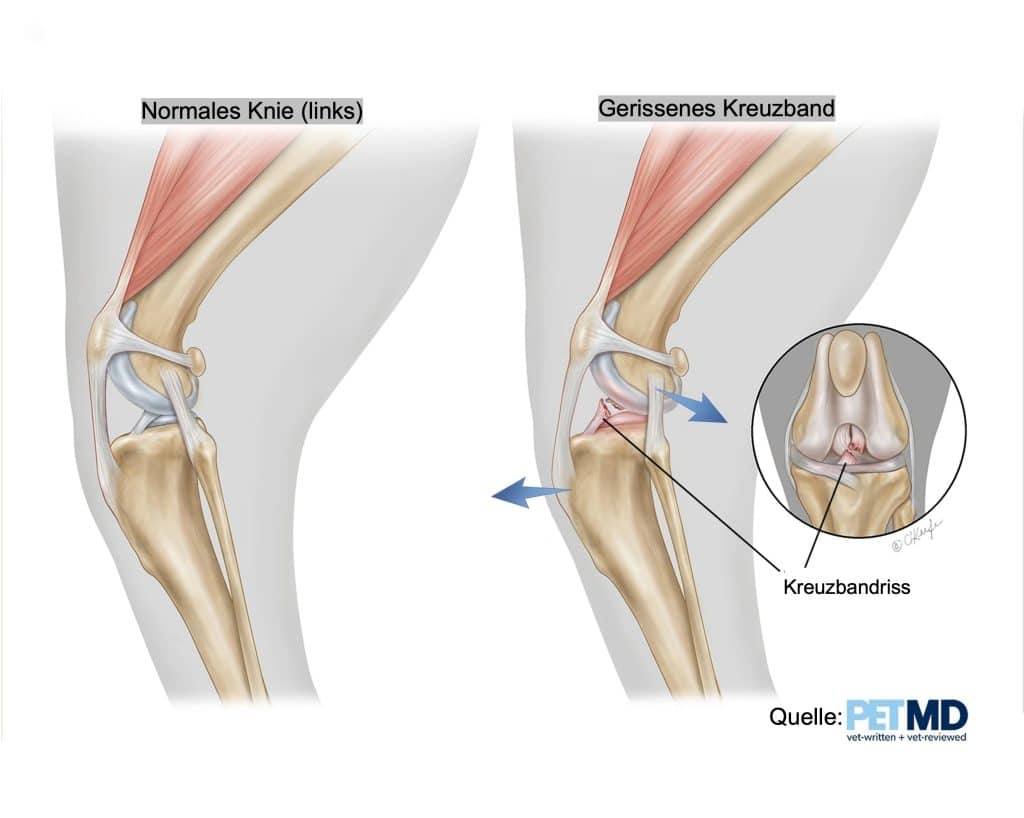What is a torn cruciate ligament in dogs?
A cruciate ligament tear or rupture is the most common cause of lameness in dogs
The trigger for cruciate ligament rupture in dogs is a chronic degenerative change in the ligaments, the cause of which is still unclear.
Accidents rarely lead to cruciate ligament tears.
In principle, any dog can become ill regardless of age, breed and gender, although larger dog breeds tend to be affected. For example, boxers, labradors, golden retrievers, rottweilers and Bernese mountain dogs have a certain tendency.
Some dogs are more likely to suffer cruciate ligament tears than others:
- Large dog breeds have a certain tendency, for example Boxers, Labradors, Golden Retrievers, Rottweilers and Bernese Mountain Dogs.
- Overweight dogs
- Senior dogs
- Sporty active dogs
- Puppies and young dogs that are still growing
In addition to the genetic predisposition are
- Overweight
- Aging processes or
- high level of physical activity
Factors that can promote cruciate ligament rupture in dogs.
The cruciate ligament: location and function

The cruciate ligaments lie in the middle of the knee joint and connect the upper and lower legs. Hyperextension and rotation of the knee are prevented by the stabilizing function of the cruciate ligament. The anterior and posterior cruciate ligaments also ensure that the upper and lower legs cannot move against each other.
Potentially, the anterior cruciate ligament (cranial cruciate ligament (CrCL)) is more susceptible to a tear (rupture) for a “canine hind leg cruciate ligament tear” because it is subject to higher mechanical stress.
In dogs, long-term degeneration causes individual fibers of the ligament to gradually tear.
→ As a result, a cruciate ligament rupture in dogs rarely occurs suddenly, but rather as a gradual symptom.
When the cruciate ligament is torn, the knee increasingly loses stability and friction occurs, which leads to osteoarthritis and meniscus damage. Prompt therapy therefore makes sense in order to avoid consequential damage. An untreated cruciate ligament rupture leads to permanent pain and lameness.
Cruciate ligament tear in dog untreated? What happens then?
A torn cruciate ligament in dogs is a very painful and debilitating injury. If left untreated, a torn cruciate ligament in dogs can lead to secondary diseases such as osteoarthritis in the knee joint and the meniscus can also be affected. This injury often leads to protective postures that cause excessive stress on the other joints. It is therefore very important that the affected animal is treated as quickly as possible after a cruciate ligament tear in order to avoid permanent damage.
If a torn cruciate ligament is not treated, it can cause the condition to worsen and there is even a risk of tearing the cruciate ligament of the other hind leg. Therefore, as a responsible dog owner, you should always keep an eye on the health of your beloved four-legged friend and consult a veterinarian immediately if there are any signs of injury.
Quick and professional treatment can help the dog's affected knee joint become functional again as quickly as possible. There are various treatment options such as conservative therapy, physiotherapy or even surgery. Your veterinarian will recommend the appropriate therapy for your dog.
However, it is also important to know that treatment can only be successful if the dog is sufficiently protected during the healing process. It is important that the dog takes rest breaks and is not placed under excessive stress. Good cooperation between veterinarian and dog owner is therefore essential to ensure a quick recovery and long-term health of the dog.
Cruciate ligament rupture dog surgery yes or no?
A torn cruciate ligament in dogs is a serious injury that often requires surgery. However, the decision as to whether surgery is necessary or not depends on various factors, such as the size and age of the dog, the degree of injury and also the type of dog sport the dog practices.
In some cases, conservative therapy may be enough to treat the injury. The dog is treated with painkillers, physiotherapy and a special orthosis. However, this can only be successful if the dog is sufficiently protected during the healing process.
In other cases, however, surgery is necessary to make the dog's affected knee joint functional again. Surgery can help relieve pain, restore mobility to the joint and minimize the risk of complications such as osteoarthritis.
However, surgery also comes with risks and often requires a longer recovery period. It is important that the dog owner is aware of the risks and benefits of the surgery and makes an informed decision in collaboration with the veterinarian.
In any case, quick and professional treatment of the cruciate ligament tear is essential to avoid permanent damage. We recommend that you seek advice from an experienced veterinarian and work with him to choose the best possible therapy for your beloved four-legged friend.
We wish your dog a speedy recovery and good health!
